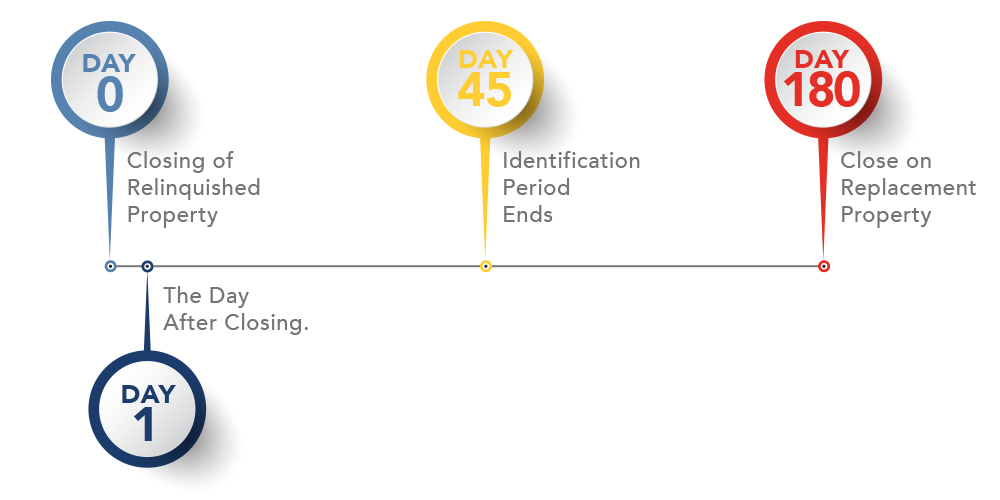1031 Exchange: Delayed Exchanges

A tax-deferred exchange allows you to preserve your wealth through reinvestment in “like-kind” assets. When you sell your interest in investment property, you may incur federal capital gains taxes and, in some states, state taxes as well. Your attorney, tax advisor, or real estate professional may suggest a tax-deferred exchange under Section 1031 of the Internal Revenue Code. A tax-deferred exchange allows you to dispose of investment properties and acquire “like-kind” properties while deferring federal capital gains taxes and depreciation recapture. Most states with a capital gain tax offer a similar tax advantage, too. Bottom line:
a tax-deferred exchange allows you to reinvest sales proceeds that would otherwise be paid to the government in the form of taxes.
UNLOCKING THE POTENTIAL
Section 1031 of the Internal Revenue Code provides a remarkable opportunity to build wealth by deferring taxes. Within carefully defined limits, this section of the Code permits you to carry forward the gains you have made on one property into another one, deferring capital gains taxes and, thus, allowing the full use of your equity in the acquisition. An exchange can be much more advantageous than the sale of one property and the purchase of another.
Let’s assume you acquired an improved property for $800,000 four years ago and intend to purchase another improved property. Your relinquished property has a current mortgage balance of $600,000 and has appreciated to $1,800,000. During the period you owned the property you have taken depreciation deductions of $100,000. Your long-term capital gains tax would total $175,000 calculated as follows:
$1,000,000 appreciation gain x 15% = $150,000.
$100,000 depreciation recapture x 25% = $25,000.
THE CONCEPT OF “LIKE-KIND”
Any real property can be exchanged, provided it is held “for productive use in a trade or business” or “for investment” and is exchanged for property of “like-kind” that will also be held for one of these same purposes. “Like-kind” does not mean “exactly the same,” particularly with the exchange of real property. A single-family rental unit, for example, may be exchanged for other real property like a warehouse, retail center, office building, farm property, or even a leasehold interest in real estate of 30 years or more.
The General Requirements for Tax-Deferred Exchanges are Clear and Simple:
IDENTIFICATION PERIOD
The replacement property must be identified within 45 days of the transfer of the first relinquished property. This 45-day rule may not be extended even if the 45th day should happen to fall on a Saturday, Sunday or legal holiday.
EXCHANGE PERIOD
The acquisition of your replacement property must be completed by the earlier of:
1. 180 days of the transfer of your first relinquished property; or
2. The due date of filing your federal income tax return for the year in which you transferred the first relinquished property, including extensions. This 180-day rule may not be extended even if the 180th day should happen to fall on a Saturday, Sunday or legal holiday.
DISASTER OR COMBAT EXTENSIONS
In some circumstances, extensions of the exchange deadlines may be available in the event you or your relinquished property are located in a Presidentially declared federal disaster area or if you are serving in a combat zone. If you think one of these extensions may apply to you, please contact us for more information.
FULLY DEFERRED EXCHANGES
For your exchange to be fully tax-deferred, your replacement property(ies) must be equal to or greater in value and equity than your relinquished property.
The debt on your replacement property(ies) must also be equal to or greater than the debt on your relinquished property unless cash is added to offset the debt.
IDENTIFICATION RULES
You may identify replacement property according to the following rules:
- 3-property rule – Three properties, regardless of value; or
- 200 percent rule – Any number of properties, as long as their combined fair market value does not exceed twice the value of the relinquished property; or
- 95 percent rule – Any number of properties, regardless of their combined fair market value, as long as you acquire 95 percent or more of the total value of such properties.
TAKING THE PROPER STEPS
[step 1] Purchase Contract-relinquished property
You and your buyer enter into a purchase contract with respect to the sale of your property (known as the “relinquished property”). This relinquished property purchase contract should contain a “cooperation clause” obligating the buyer to cooperate in structuring the transaction as a tax-deferred exchange.
A sample cooperation clause may look like:
Buyer acknowledges that Seller intends to perform a tax-deferred exchange pursuant to Section 1031 of the Internal Revenue Code. Buyer agrees to an assignment of this contract by Seller (“Exchangor”) to First American Exchange Company, a Qualified Intermediary (QI), to effectuate the exchange. Buyer agrees to cooperate in such exchange provided that Buyer incurs no cost or liability.
[step 2] Relinquished property exchange documents
Next, contact First American Exchange to start the tax-deferred exchange process. We will prepare an ‘Exchange Agreement’, an ‘Assignment of the Relinquished Property Purchase Contract’ (assigning your rights as the seller to us), a ‘Notice of the Assignment’ (for delivery to the buyer), and instructions to the settlement agent necessary to complete the transaction. All of these documents must be executed on or before the date of closing.
[step 3] Closing the relinquished property
When the conditions of closing have been met, your relinquished property will be conveyed to the buyer. While the conveyance will be directly from you to the buyer, it will represent a transfer from you to First American Exchange in exchange for other property that you will receive at a later date. It also represents the sale from First American Exchange to the buyer for cash. The cash proceeds from the sale of the relinquished property must be delivered directly to First American Exchange. At no time should you be in either actual receipt or constructive receipt of the cash proceeds, or your exchange could fail.
[step 4] Relinquished property proceeds and forms
Following the relinquished property closing, First American Exchange will hold the exchange proceeds and provide you with forms to identify potential replacement properties within the 45-day identification period.
[step 5] Purchase Contract – replacement property
After you have identified suitable “like-kind” replacement properties and made a decision as to which identified properties you intend to acquire, you will enter into a ‘Purchase Contract’ with the seller. This ‘Replacement Property Purchase Contract’ should also contain a “cooperation clause” obligating the seller to cooperate with you in completing your tax-deferred exchange.
A sample cooperation clause may look like:
Seller acknowledges that Buyer intends to perform a tax-deferred exchange pursuant to Section 1031 of the Internal Revenue Code. Seller agrees to an assignment of the Contract by Buyer to First American Exchange Company, a Qualified Intermediary, to effectuate the exchange. Seller agrees to cooperate in such exchange, provided that Seller incurs no cost or liability.
[step 6] Replacement property exchange documents
First American Exchange will then prepare an ‘Assignment of the Replacement Property Purchase Contract’ (assigning your rights as the buyer to us), ‘Notice of the Assignment’ (for delivery to the seller), and instructions to the settlement agent necessary to complete the transaction. All of these documents must be signed before or as of the date of closing.
[step 7] Closing the replacement property
When the conditions of closing have been met, First American Exchange will deliver the exchange proceeds to the settlement agent to acquire the replacement property. The seller will convey the replacement property directly to you. This conveyance will represent a purchase from the seller by First American Exchange and a transfer to you in completion of the exchange. Remember that, to qualify for tax-deferred treatment, this closing must occur by the earlier of 180 days from the date of closing on your first relinquished property or the due date of filing your federal income tax return for the year in which your first relinquished property was sold, including extensions.
[step 8] Keeping you informed and final reconciliation
Prior to or at the conclusion of your exchange, First American Exchange Company will provide you with a copy of your exchange documents, including a statement reflecting the receipt and disbursement of all exchange funds. With this information, you and your tax advisor will complete Form 8824 to be filed with your federal income tax return, as well as any state forms required to report the transaction as an exchange.
First American Exchange Company understands the importance of having complete and accurate documentation of your exchange transaction in the event you are audited.
SPECIAL CIRCUMSTANCES TO BE CONSIDERED
Certain provisions of the regulations must be taken into account for the qualifications, structure, and documentation of your exchange. Please let us know if any of the following circumstances apply to your transaction, so that we may provide you with additional information for you and your tax advisor to consider:
- Disposition of a property held by a partnership, corporation, or limited liability company
- Exchanging property with a related party
- Disposition of property held in a living trust
- Receiving cash from the exchange
- Acquiring property of a lesser value than the relinquished property
- Carrying financing on the relinquished property (seller carry back note)
- Acquiring replacement property in the following tax year
- A reverse exchange transaction
- Improvements that will be made to the replacement property (construction/improvement exchanges)
- Acquiring replacement property with a spouse or others who were not a party to the exchange
- Combination exchange, part investment property (IRC Section 1031) and part owner-occupied (IRC Section 121)
- Residing in a state other than where the relinquished property is located.
This article was originally published by Janna Perret of First American Exchange Company at https://www.firstexchange.com/content/delayed-exchange. To learn more about 1031 Exchanges you may contact Janna Perret, the Central Region Manager at First American Exchange Company, by phone at 504-539-5933 or view her PROFILE.
Information provided with permission from First American Exchange Company. All rights reserved. First American Exchange Company makes no express or implied warranty respecting the information presented and assumes no responsibility for errors or omissions.



